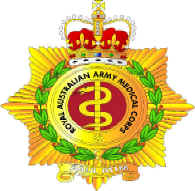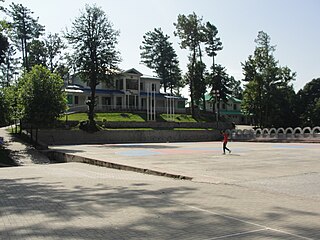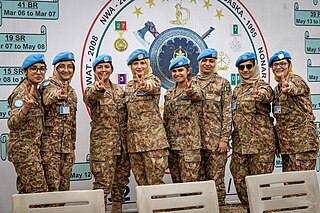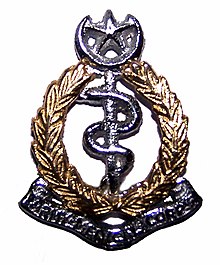
The Pakistan Armed Forces are the military forces of Pakistan. It is the world's sixth-largest military measured by active military personnel and consist of three formally uniformed services—the Army, Navy, and the Air Force, which are backed by several paramilitary forces such as the National Guard and the Civil Armed Forces. A critical component to the armed forces' structure is the Strategic Plans Division Force, which is responsible for the maintenance and safeguarding of Pakistan's tactical and strategic nuclear weapons stockpile and assets. The President of Pakistan is the Commander-in-Chief of the Pakistan Armed Forces and the chain of command is organized under the Chairman of the Joint Chiefs of Staff Committee (JCSC) alongside the respective Chiefs of staffs of the Army, Navy, and Air Force. All branches are systemically coordinated during joint operations and missions under the Joint Staff Headquarters (JSHQ).

The Royal Australian Army Medical Corps (RAAMC) is the branch of the Australian Army responsible for providing medical care to Army personnel. The AAMC was formed in 1902 through the amalgamation of medical units of the various Australian colonies and was first deployed to South Africa as a small detachment of personnel supporting the Australian Commonwealth Horse during the Second Boer War. The corps has participated in every Australian Army operation since then, including wars and peacekeeping operations. The "Royal" prefix was granted in 1948.

The Pakistan Army, commonly known as the Pak Army is the land service branch and the largest component of the Pakistan Armed Forces. The president of Pakistan is the supreme commander of the army. The Chief of Army Staff (COAS), a four-star general commands the army. The Army was established in August 1947 after Pakistan gained independence from the United Kingdom. According to statistics provided by the International Institute for Strategic Studies (IISS) in 2023, the Pakistan Army has approximately 560,000 active duty personnel, supported by the Pakistan Army Reserve, the National Guard and the Civil Armed Forces. Pakistani citizens can enlist for voluntary military service upon reaching 16 years of age, but cannot be deployed for combat until the age of 18 in accordance with the Constitution of Pakistan.

The 3rd Marine Logistics Group is the Logistics Combat Element (LCE) for III Marine Expeditionary Force currently headquartered on Camp Kinser, Marine Corps Base Smedley D. Butler, Okinawa, Japan. 3rd MLG provides combat service support (CSS) to III MEF units above the organic capability. CSS is the essential capabilities, functions, activities, and tasks necessary to sustain all elements of operating forces in theater at all levels of war. Combat service support includes, but is not limited, to supply, maintenance, transportation, general engineering, health services, and other services required by aviation and ground combat forces to permit those units to accomplish their missions.
Major General Shaukat Sultan Khan, HI(M), afwc, psc, is a former Director General of the ISPR, the PR wing of the Pakistani Armed Forces. He served from 2003 to 2007.

The Republic of Korea Army Special Warfare Command, also known as the Republic of Korea Army Special Forces "Black Berets", is a strategic-level military command of the Republic of Korea Army responsible for their special operations forces. ROK Special Forces brigades work in a close relationship with their United States Army Special Forces counterparts and other allies in international security and intervention missions. U.S. SOF in Korea are under the command and control of Special Operations Command Korea (SOCKOR) which is a sub-unified command assigned under the Korean Armed Forces Command.

Pakistan has served in 46 United Nations peacekeeping missions in 29 countries around the world. As of 2023, United Nations (UN) statistics show that 168 Pakistani UN peacekeepers have been killed since 1948. The biggest Pakistani loss occurred on 5 June 1993 in Mogadishu. Pakistan joined the United Nations on 30 September 1947, despite opposition from Afghanistan because of the Durand Line issue. The Pakistan Armed Forces are the sixth largest contributor of troops towards UN peacekeeping efforts, behind Ethiopia and Rwanda.

General Ashfaq Parvez KayaniNI(M) HI(C) HI(M) LoM LoH OMM, is a retired four-star general of the Pakistan Army who served as the eighth chief of army staff, being appointed on 29 November 2007 after his predecessor Pervez Musharraf retired from his military service and remained in the office until 29 November 2013.

Combined Military Hospitals are Pakistan Armed Forces hospitals situated in various cantonments of Pakistan.
The Pak Emirates Military Hospital Rawalpindi, commonly known as Military Hospital Rawalpindi, is a public hospital in Rawalpindi, Pakistan. It is the largest hospital of the Pakistan Armed Forces, being one of the hospitals in the Pakistan Army with an ISO certification, located in the city of Rawalpindi. Before independence in 1947 it was called the British Indian Military Hospital Rawalpindi.
The Combined Military Hospital Rawalpindi is a tertiary care military hospital in Rawalpindi. It is headed by a Major General from the Army Medical Corps (Pakistan). It provides specialized treatment to the armed forces personnel and their immediate families.

The Army Medical Corps is a specialist corps in the Indian Army, which primarily provides medical services to all Army personnel, serving and veterans, along with their families. Along with the branches in the Indian Navy and Indian Air Force, it forms part of the Armed Forces Medical Services (AFMS). The AFMS consists of around 60,000 personnel.

The Pakistan Army Special Service Group is the special operations forces of the Pakistan Army. They are also known by their nickname of "Maroon Berets" due to their headgear.

Military College Murree or MCM, is a military high school, located at Upper Topa, Murree Tehsil, District Rawalpindi, Pakistan. It was inaugurated by COAS Gen.Ashfaq Pervaiz Kiyani NI(M),HI on 1st of September, 2008.

Women in the Pakistan Armed Forces are the female officers who serve in the Pakistan Armed Forces. Women have been taking part in Pakistani military since 1947, after the establishment of Pakistan. In 2006, the first women fighter pilot batch joined the combat aerial mission command of PAF. The Pakistan Navy prohibits women from serving in the combat branch. Rather, they are appointed and serve in operations involving military logistics, staff and senior administrative offices, particularly in the regional and central headquarters. There was a rise in the number of women applying for the combat branch of PAF in 2013.

The National University of Medical Sciences, commonly referred as NUMS, is a public university located in Rawalpindi, Punjab, Pakistan.

Lieutenant General Nigar Johar KhanHI(M) TI(M) is a retired three-star general in the Pakistan Army. Nigar is the first and only woman in the history of Pakistan Army to reach the rank of lieutenant-general, and the third to reach the rank of major-general. She belongs to the Pakistan Army Medical Corps and served as the surgeon general of Pakistan Army and Colonel commandant of Army Medical Corps. The other five women major-generals Shahida Badsha, Shahida Malik, Shehla Baqai, Abeera Chaudhry and Shazia Nisar also belong to the Army Medical Corps.
The Combined Military Hospital Lahore is the largest tertiary care teaching hospital operated by the Pakistan Army. Its primary function is to provide specialized medical treatment to Armed forces personnel, their dependents, as well as the general public. It is headed by a Brigadier from the Army Medical Corps of the Pakistan Army.

The Civil Armed Forces (CAF) are a group of nine paramilitary, uniformed organisations, separate and distinct from the regular "military" Pakistan Armed Forces. They are responsible for maintaining internal security, helping law enforcement agencies, border control, counter-insurgency and counter-terrorism, riot control, and anti-smuggling under the Ministry of Interior. They frequently operate alongside the Pakistani military in response to natural disasters. They come under the direct command of the Ministry of Defence and the Pakistani military during wartime.

Lieutenant General Shafaat Ullah Shah HI(M) is a retired three star general of the Pakistan Army, diplomat, and author. He often writes for the Pakistan Armed Forces magazine, "Hilal English". He has served as Chief of Logistics Staff at the GHQ, Colonel Commandant of the Baloch Regiment, Commander IV Corps, and as Military Secretary to President Musharraf.



















